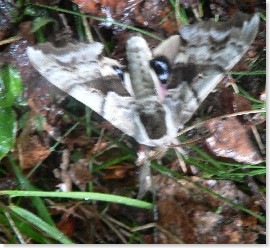 The picture is not too clear, the wings of the moth were vibrating when I took the shot. It was still early in the day when I came across her so I suspect she may have been warming herself. But in the brief moment her wings were still I was amazed by the evolutionary intelligence I was witnessing.
The picture is not too clear, the wings of the moth were vibrating when I took the shot. It was still early in the day when I came across her so I suspect she may have been warming herself. But in the brief moment her wings were still I was amazed by the evolutionary intelligence I was witnessing.
It’s difficult to see in the picture but this blue-eye wing-patterned moth keeps its predators away by looking for all the world like a predator itself. The visual effect, with both wings splayed, is that of the face of a cat. A good thing when your predators are mostly birds.
It’s a deception that works. Any bird on the hunt will take one look and glide on. The eye-spots on the wings are a kind of power equalizer.
In this context I’ve sometimes wondered if deception can be a form of truth. I recall a story a friend told me about a grade-school teacher who in front of the entire class asked a student if his father was abusing him. To the teacher, it was obvious that something of the sort was happening, but the student said no. The ignorance of the teacher notwithstanding, the student, in a very real sense told the truth. In that public context, in front of peers, friends and everyone else…how else could the young boy have answered? To say no was as natural and right as having eye-spots on his wings. Context is still often everything.
I grew up in a Christian tradition that told us that all deception, all lying, was wrong. I recall the seriousness of a childhood debate in which we posed the question that if the Gestapo/Nazis etc. came to your door, would you lie or not, to keep your family safe. We were taught to be less wise than moths.
We can learn from the moth. Where there exists a power structure injurious to the life and well-being of a weaker person, a lie can be truer than the truth.

You’ve given us another keen insight.
It reminds me of a rock star’s cliche that
is ‘true’ enough in its own way
‘love is the higher law’
Bono